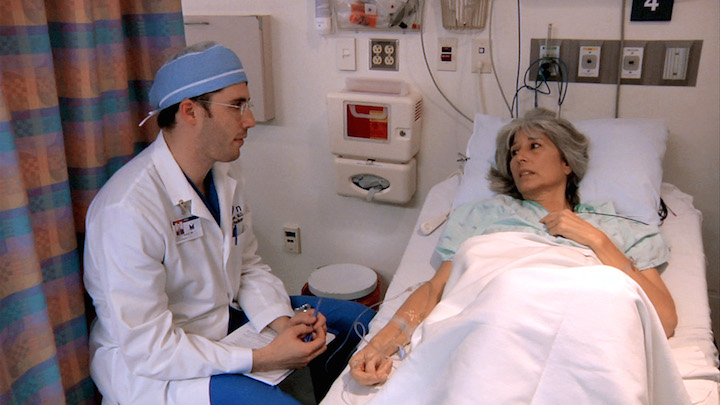20 Documentaries About Death and Dying
Article originally published by: Nofics.com
America treats many subjects in a bafflingly schizoid manner, but none more so than death (well, maybe sex). We are a war culture that loves entertainment soaked in violence, both of the cartoonishly brutal and the strangely sanitized varieties. But we are grossly uncomfortable with confronting actual death. We talk about disease in terms of “fighting battles,” a frame of reference that denies death as an inevitability. We confine the dying to nursing homes and hospital wards where we don’t have to look at or think about them. These are the places we do not see as often in movies and television shows.
But documentaries often go where other films don’t dare. There are a lot of nonfiction films that confront death head-on, enough that there’s a considerable variety to how they go about it. Even more docs deal with death tangentially in a way that’s weightier than most fiction films can muster. Any war doc worth its salt, for instance, makes the constant peril a much more tangible reality than all but a few fiction war movies.
Inspired by A Will for the Woods, here is a look at documentaries that make the end of life their chief concern. All seek to start the uncomfortable existential questions we’re only too happy to put off for as long as we can — sometimes until it’s too late.
Gates of Heaven
Funnily enough, the only notable doc about a cemetery is not about a human burial ground. Famously, Werner Herzog (more on him in a bit) pledged that he would eat his shoe if Errol Morris was able to successfully complete this film. Morris did so, and Herzog ate his shoe (in another movie, by Les Blank, because Herzog is awesome). That Morris made a compelling movie about pet cemeteries with his very first feature set the tone for the rest of his career. Right away, he excelled at extracting odd profundity from normal but quirky individuals.
As each of the people in the film talk about the pets they’ve lost or the business of burying them, it’s soon apparent that what they’re really talking about are their views in general concerning life, death and the afterlife. One woman soon breaks away from talk of her pet into a beautiful monologue about her youth and the descendants she has now. Which dovetails nicely into another man’s speculation that, for some people, pets are substitutes for children or grandchildren. So much of life is seeking love, and we’ll find it in other creatures if we have to. And you’ll demonstrate that love by giving them the same respect you would a human being after they die. Judge them for this if you wish — Morris certainly doesn’t.
Mondo and Experimental Films
Mondo films, or exploitation documentaries, or shockumentaries, experienced their heyday from the ’60s through the ’80s. Freely mixing fact and fiction, these films were made for one thing: to draw viewers by any lurid means necessary. The genre kicked off in 1962 with Mondo cane (“A Dog’s World”), an Italian travelogue of grotesqueness. Some of the scenes of slaughterhouses, wild animal encounters and rituals are staged, and some are not. Directors Gualtiero Jacopetti, Paolo Cavara and Franco E. Prosperi would go on to concoct more films in the genre, Jacopetti and Prosperi eventually making Addio Zio Tom (“Goodbye Uncle Tom”), a “time travel film” that reenacts many historical horrors of American slavery.
In America, the height (or low-point) of the mondo movies was Faces of Death, 1978’s crash reel of horrible ways to perish. Somewhere in the neighborhood of half the scenes in the film are faked, but that didn’t stop it from raking in over $30 million in theaters. It went on to get five sequels.
Mondo films are the near-antithesis of most of the others discussed here, but they are worth mentioning. There is nothing respectful about them — they are confrontational works, showing us with visceral urgency the fragility of the human body. In that respect, they have a curious counterpart in Stan Brakhage‘s The Act of Seeing With One’s Own Eyes, a short film that observes an autopsy in unsparing detail. We are, as Terry Bisson called us, “thinking meat,” and work like this is an unsentimental reminder of this fact.
Sick: The Life and Death of Bob Flanagan, Supermasochist
Bob Flanagan died at age 43. That sounds too soon, but it was actually astonishing that he made it that far. He had cystic fibrosis, which at the time of his birth carried a life expectancy in the single digits. He credited his longevity to his extreme lifestyle, which incorporated liberal indulging in BDSM and other acts of self-harm for self-pleasure. This film explores his life and work as a performance artist, poet and musician. He used much of his art to process the everyday threat of death under which he lived.
Such an awareness of mortality made Flanagan absolutely fearless, and the doc asks the audience to not look away from his antics. There are the low-key stomach-churning scenes, like one in which he shows off his latest project, a small model of a human body that spews oozing pus from every orifice. There are scenes of him and his partner Sheree engaging in BDSM acts. And then there is the sequence in which he hammers a nail through his penis. Unedited. In close up. What might be most unshakeable, though, is the ending, in which a delighted-looking Bob lies in a coffin and sings about how good it is to be dead. Director Kirby Dick would later go on to make another, more traditional documentary about terminal illness, The End.
Death by Design
This science doc explores the phenomenon of cell regeneration. We are not only meat, but meat composed of countless smaller bits of meat, all of which are acting in concert to maintain the integrity of the wholes — our bodies. At any given moment, billions of pieces of yourself are dying, replaced by new pieces. What you are today is not what you are a few years ago. Eventually, the process breaks down, and the mass dies more quickly than it can produce more of itself. This film’s dazzling microscopic cinematography compares the movements of cells to those of dancers on a stage. Life is a wondrous thing to behold at any level, and death is always a part of it.
AIDS Films
While America struggled to understand, much less come to terms with what AIDS is, millions died. The epidemic remains a tremendous touchstone in the LGBT community and the history of the ’80s and ’90s. Several documentaries made then and since have looked a the disease. 1989’s Common Threads: Stories from the Quilt examines the role that remembrance plays in our lives, as the loved ones of six people featured in the AIDS Memorial Quilt tell their stories. 1993’s Silverlake Life: The View from Here is an intensely personal view of living with AIDS, a video diary by a couple who both have it.
Rock Hudson’s Home Movies, which generally takes a wink-wink approach in curating suggestive scenes from the actor’s filmography, turns more somber when it forms parallels to his final years of illness. We Were Here is a work looking at the crisis as history rather than from a contemporary standpoint, as five people who lived in the thick of its onset in San Francisco reminisce about what they saw and experienced.
Living in an epidemic makes death a presence in a way unlike anything else. From one year to the next, you stand to lose multiple friends, maybe even a lover. It’s a grim reality, and it’s something we absolutely need to acknowledge and commit to memory.
So Much So Fast
There are two ways to approach death: you can accept it, or you can fight it. This film, from Troublesome Creek directors Steven Ascher and Jeanne Jordan, showcases both of these reactions. When Stephen Heywood was diagnosed with ALS at age 29, he resolved simply to live, to do his best to carry on as normal in the time he had left. His brother James, on the other hand, throws himself fully into the hope that Stephen can be cured. He builds an ALS-fighting organization from the ground up, using it to perform fast-tracked research into treatment.
Currently, a big viral trend is the “Ice Bucket Challenge,” in which people dump a bucket of ice water over their head, challenge a friend to do the same, and do so via an Internet video. If the challenged person fails to perform the act within 24 hours, they must donate $100 to an ALS-related organization. The idea is to spread awareness of the disease. Since ALS is so rare, research into treatment is an underfunded non-priority for most drug companies, so the sentiment is laudable (and the Challenge has raised over $16 million, so it’s clearly struck a chord). Still, it demonstrates that we are definitely a society of James’s and not Stephens. More than anything else, So Much So Fast demonstrates how surprisingly normal daily life can be, even with a serious condition. There’s value to be found in Stephen’s calm acceptance of his fate.
The Bridge
Almost every single person who has survived jumping off the Golden Gate Bridge has said that they regretted their decision the moment they let go. That horrible fact lodges itself in the mind during this movie, which captures 23 of the 24 known suicides that took place on the Bridge during 2004. Director Eric Steel filmed the bridge for the entire year, and tracked down the friends and family of the victims, who talk about their lives and why they might have done what they did. If you watch this film, then you will watch people die — this has been a significant source of controversy, understandably so.
This is the furthest you can get from the leering quality of the mondo crowd. It’s filmed death, but at a literal remove, as the cameras were positioned a long way from the Bridge. And these aren’t anonymous figures. We learn their names, their lives, their pain. Like nothing else, The Bridge attempts to get inside the mindset of someone who makes the choice to cease their existence, complete with its follow-through. It’s haunting like few things are.
How to Die in Oregon
The flip side of those who commit suicide out of emotional pain are those who do so to end physical pain. Oregon was the first state to legalize physician-assisted suicide (and to date is one of just five states to do so). With the law no longer acting as a barrier to euthanasia, How to Die in Oregon examines how a new culture around dying and dealing with terminal illness develops. Main character Cody faces an option that not many people throughout history have had: she can plan her own last days, the same way one can schedule dental appointments and meet-ups with friends.
There are multiple stories out there about people making and ticking off bucket lists, but this doc is different because it takes that plot thread to its logical endpoint. The filmmakers create a respectful distance by leaving their audio equipment with Cody and her family as they say their goodbyes and she takes the drugs that will send her into her final coma. Their cameras remain outside, recording a heartbreakingly beautiful evening sun setting against a window. It’s intense in a personal, intimate way unlike any other real death in a documentary.
Werner Herzog
Everyone’s favorite German madman makes it a habit to look into the cold, unfeeling depths of the universe. The primordial chaos is a theme that runs through multiple films of his, perhaps most notably in Grizzly Man, which is centered around the circumstances that lead to two horrible deaths in the wilderness. In a marked departure from some of the other films here, Herzog refuses to share the recording that exists of Timothy Treadwell’s demise. In fact, he advises that it be destroyed. Herzog often uses artifice, abstraction and re-creation in his work, so it makes sense that he would want to avoid exposing Treadwell, for whom he admits some respect, in this way.
Death is in the background for some of Herzog’s other efforts, such as how Encounters at the End of the World uses Antarctica’s isolation as a parable for mankind’s isolation. But the idea is front and center in Into the Abyss, as well as its related television series On Death Row. In both, Herzog interrogates men who are soon to be executed and what it’s like to stare down death that is coming unnaturally soon, in retribution for the harm they have done to others. That’s a perturbing mindset, one that Herzog is unafraid to inhabit. But then, he fears nothing.
Life Itself
When Gene Siskel learned he had a fatal brain tumor, he kept it a secret from all but close family, leaving many of his friends and colleagues dumbfounded by his departure. Even his TV partner, Roger Ebert, didn’t know the true extent of Siskel’s illness until after his death. Ebert, then, resolved that he would not act the same way were he put in a similar position. And he didn’t. As he lost his jaw to cancer, the venerated film critic kept up an admirable level of candor and good humor. In the final years of his life, he became just as well-known for his remarkably calm attitude towards death as he was for his criticism.
That philosophy is carried on in Life Itself, director Steve James‘s biography of Ebert. Though he undergoes some horrible medical procedures with the camera rolling, Ebert maintains an uncanny sense of peace. After his death, the frame lingers a while on an empty room, allowing the void left by loved one’s passing to seep into the audience. But the movie urges the viewer to dwell on the positive side, like Dr. Seuss’s old admonition to be happy that something happened, rather than sad that it’s over. Any movie that focuses on death is really about life and how we choose to use it. As befits its title, Life Itself uses Ebert as an example of how to have a fulfilling life.
And here are a few more for good measure: Team Spirit, The Ossuary, Transcendent Man, The Last Campaign of Governor Booth Gardner, The Suicide Tourist, Lightning Over Water and Griefwalker.
Read more at http://nonfics.com/death-and-dying-documentaries/#9ysw3umdJLEZLQK6.99
Photo: Docurama




